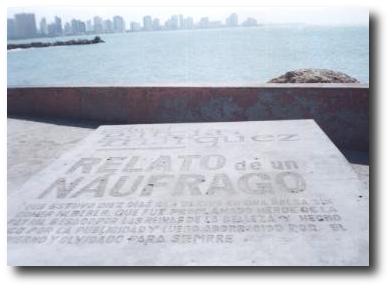
Cartagena has some strange monuments. There
is a statue of a giant crab on Avenida Santander.
Then there is the statue of a flock of pelicans
in front of the Hotel Santa Clara, and the giant
bronze casting of a pair of old boots behind
the Fort of San Felipe. In front of this same
fort stands the statue of Admiral Don Blas de
Lezo with his one eye, one arm and wooden leg,
above oversize facsimiles of British coins depicting
his defeat - a defeat which never took place.
But perhaps the oddest memorial is a concrete
slab you pass when walking along the sea-front
between Cartagena's central district and Bocagrande.
It commemorates a small disaster which, quite
literally, changed the course of Colombian history.

The monument itself is a
simple slab, in the shape of a book, lying horizontal,
about the size of a double bed mattress. Its
cover reads:
"Gabriel García Márquez.
Relato de un Náufrago.
Que estuvo diez dias a la deriva en una balsa
sin comer ni beber. Que fue proclamado héroe
de la patria. Besado por las reinas de la belleza
y hecho rico por la publicidad y luego aborricido
por el gobierno y olvidado para siempre"
This
translates as:
"Gabriel García Márquez.
Story of a Shipwrecked Sailor
That was stranded 10 days in a raft without
food or water. That was proclaimed a national
hero. Kissed by beauty queens and made rich
by the publicity and later hated by the government
forgotten forever"
Luís Alejandro Velasco was one of several sailors
who were washed overboard from the Colombian
Naval vessel the Caldas, returning from
the USA to the Port of Cartagena in 1955. Only
he made it to the liferaft, though he remembers
seeing his friends swimming vainly towards it.
There was no food or survival equipment in the
raft. A search plane passes overhead but fails
to spot him. Everyday at 5pm Velasco sees sharks
start to circle his small raft. He catches a
seagull and tries to eat it raw. He hallucinates
about his drowned comrades and girlfriend. Praying
to the Virgin, he becomes convinced he will
not survive the ordeal and lashes himself to
the raft in the hope his body will eventually
wash ashore and his fate be known. The tale
doesn't end when he sees land, summons the last
of his strength and swims to a deserted shoreline:
Velasco must set off into the hills in his emaciated
state looking for someone not knowing if he
has come ashore in Colombia, Panama, or some
island.
 Velasco
had washed ashore in his homeland. Velasco
had washed ashore in his homeland.
The Colombian dictator of the time, General
Rojas Pinillas, feted him as a national hero.
Velasco was a celebrity in hot demand and already
very rich when he decided to sell his story
to the El Espectador newspaper. The paper's
27 year-old cub reporter was Gabriel García
Márquez. After interviewing Velasco with a pen
and notepad in 20 grueling 6-hour sessions over
several weeks, Márquez sat down and turned what
at first appears as a boring story - ten days
drifting alone in a liferaft - into one of the
most gripping tales of survival ever written.
Márquez ghost-wrote the voice of Velasco in
14 serialized installments.
The articles gripped the nation. When Velasco
started to contradict the official version of
events that he had been washed overboard in
a storm, circulation soared even higher. Then
El Espectador obtained undeveloped films
from Velasco's crewmates and published them.
They clearly showed the deck of the Caldas
overloaded with cargo - refridgerators and other
contraband - proving the Colombian Navy was
involved in smuggling, and the overloading was
the real cause of the accident. This led to
Velasco's dismissal from the Navy, and the closure
of the El Especatador newspaper. Gabriel
García Márquez was forced into exile and the
whole scandal eventualy brought about the fall
of the Rojas Pinilla government.
Gabriel Garcia Márquez went on to fame and fortune
with his fiction. In the 1970's the publishing
world cashed in on his name, and came out with
an English language version of the articles
in book form. It was an instant success. But
as Márquez points out in the introduction, he
is not really the author. Velasco is.
Marquez's
Cartagena residence, a luxurious mansion by
anyone's measure, is just a few metres from
the monument, overlooking the sea in which the
story was set.
Velasco died of cancer in 2000, like the monument
says, all but fogotten.
Photo
and story copyright of Glen David Short, a freelance
writer based in Cartagena. His new adventure
travelogue, `An Odd Odyssey: California to Colombia
by bus and boat' has just been published
by Trafford Publishing.
-
B A C K -
Text
and Photos Copyright 2005 Glen David Short
|